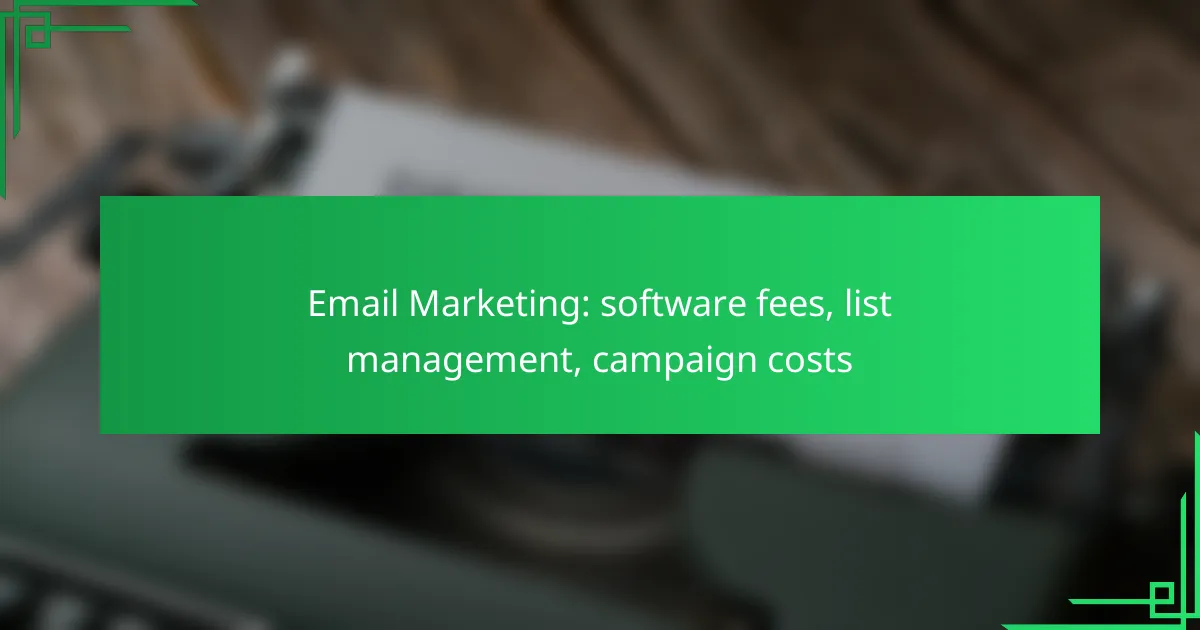Email marketing is a powerful tool for businesses, but understanding the associated costs is crucial for effective budgeting. From software fees that vary based on features and user base to the expenses linked with managing and segmenting your email list, each aspect plays a significant role in your overall marketing strategy. Additionally, campaign costs can fluctuate widely, influenced by factors such as list size and campaign complexity, making it essential to plan accordingly.

What are the costs of email marketing software in the UK?
The costs of email marketing software in the UK can vary widely based on features, user base, and pricing models. Businesses typically encounter monthly subscription fees, pay-as-you-go options, and free tiers, each with its own advantages and limitations.
Monthly subscription fees
Monthly subscription fees for email marketing software in the UK generally range from £10 to £500, depending on the number of subscribers and features included. Most platforms offer tiered pricing, where higher tiers provide additional functionalities like automation, advanced analytics, and enhanced customer support.
When selecting a subscription plan, consider your current and projected subscriber count, as exceeding your plan’s limit can lead to additional charges. It’s also wise to evaluate the return on investment by estimating potential revenue generated from your email campaigns.
Pay-as-you-go pricing
Pay-as-you-go pricing allows businesses to pay only for the emails they send, which can be beneficial for those with fluctuating email volumes. Prices typically range from £0.01 to £0.05 per email, depending on the provider and volume purchased.
This model is ideal for small businesses or those just starting with email marketing, as it avoids the commitment of a monthly fee. However, it can become costly if email volumes increase significantly, so monitoring usage is essential.
Free tier options
Many email marketing platforms in the UK offer free tier options, which usually allow a limited number of subscribers and emails per month. Common limits might be around 2,000 subscribers and 10,000 emails monthly, making it a great starting point for small businesses or individuals testing the waters.
While free tiers provide essential features, they often lack advanced tools like automation and detailed analytics. If you find your needs growing, transitioning to a paid plan may be necessary to access more comprehensive capabilities.

How to manage your email marketing list effectively?
Managing your email marketing list effectively involves organizing your contacts to maximize engagement and conversion rates. This includes using segmentation strategies and list cleaning techniques to ensure your messages reach the right audience and maintain a healthy subscriber base.
Segmentation strategies
Segmentation strategies involve dividing your email list into smaller groups based on specific criteria such as demographics, behavior, or purchase history. This allows for more targeted messaging, which can significantly improve open and click-through rates.
Common segmentation criteria include age, location, and past interactions with your emails. For example, you might send promotional offers to customers who have previously purchased related products, while providing informational content to new subscribers.
List cleaning techniques
List cleaning techniques are essential for maintaining an effective email marketing list. This process involves regularly removing inactive subscribers and correcting invalid email addresses to improve deliverability and engagement rates.
To clean your list, consider implementing a routine check every few months. Look for subscribers who haven’t engaged in a while and consider sending a re-engagement campaign before removing them. Additionally, use tools that automatically verify email addresses during sign-up to minimize errors.

What are the typical campaign costs for email marketing?
Typical campaign costs for email marketing can vary widely based on factors such as the size of your email list, the complexity of your campaigns, and the tools you use. Generally, businesses can expect to spend anywhere from a few hundred to several thousand dollars per campaign, depending on their specific needs and goals.
Design and content creation expenses
Design and content creation expenses are crucial for effective email marketing. Costs can range from hiring freelance designers and copywriters to using templates and in-house resources. Freelancers may charge anywhere from $50 to $150 per hour, while pre-made templates can cost between $20 and $200 each.
When budgeting for design, consider the quality of visuals and the effectiveness of your messaging. Investing in high-quality graphics and compelling copy can significantly enhance engagement rates, making it worthwhile to allocate a reasonable budget for these elements.
Delivery and tracking fees
Delivery and tracking fees are essential components of email marketing costs. Most email marketing platforms charge based on the number of subscribers or emails sent, with monthly fees typically ranging from $10 to several hundred dollars, depending on the service and features included. Some platforms may also charge per email sent, which can add up quickly for larger campaigns.
In addition to basic delivery fees, consider investing in tracking tools that provide insights into open rates, click-through rates, and conversions. These analytics can help refine your strategy and improve future campaigns, making them a valuable addition to your overall email marketing budget.

What features should you look for in email marketing software?
When selecting email marketing software, prioritize features that enhance campaign effectiveness and streamline list management. Key functionalities include automation, analytics, and user-friendly interfaces to optimize your marketing efforts.
Automation capabilities
Automation capabilities allow you to set up workflows that send emails based on specific triggers, such as user actions or time intervals. This can significantly increase engagement by delivering timely messages without manual intervention.
Look for features like drip campaigns, autoresponders, and segmentation options. For example, you can automate welcome emails for new subscribers or follow-up messages for abandoned carts, which can improve conversion rates.
Analytics and reporting tools
Analytics and reporting tools are essential for measuring the success of your email campaigns. They provide insights into open rates, click-through rates, and subscriber engagement, helping you refine your strategies over time.
Choose software that offers customizable reports and real-time data tracking. This allows you to assess performance metrics and make data-driven decisions. For instance, if you notice a low open rate, you might experiment with different subject lines or send times to improve results.

How can you optimize email campaigns for better ROI?
To optimize email campaigns for better ROI, focus on strategies that enhance engagement and conversion rates. Implementing targeted approaches like A/B testing and personalization can significantly improve your campaign performance and ultimately lead to higher returns.
A/B testing strategies
A/B testing involves comparing two versions of an email to determine which one performs better. This can include variations in subject lines, content layout, images, or call-to-action buttons. By analyzing metrics such as open rates and click-through rates, you can identify the most effective elements for your audience.
When conducting A/B tests, ensure you test one variable at a time to isolate its impact. Aim for a sample size that is statistically significant, which typically means sending your emails to a few hundred or thousand recipients. This will help you draw reliable conclusions and make informed adjustments to your campaigns.
Personalization techniques
Personalization techniques involve tailoring your email content to the specific interests and behaviors of your recipients. This can range from using their names in the subject line to recommending products based on previous purchases. Personalized emails can lead to higher engagement rates, often resulting in increased sales.
To effectively personalize your emails, segment your audience based on demographics, purchase history, or engagement levels. Utilize data analytics tools to gather insights and create targeted campaigns. Avoid overloading your emails with too much personalization, as this can feel intrusive; instead, focus on relevant and meaningful content for each recipient.

What are the best email marketing platforms available in the UK?
The best email marketing platforms in the UK offer a range of features to help businesses manage their campaigns effectively. Key considerations include pricing, ease of use, automation capabilities, and customer support.
Mailchimp
Mailchimp is a popular email marketing platform known for its user-friendly interface and robust features. It offers a free tier for small businesses, making it accessible for those just starting out. Paid plans typically range from £10 to £300 per month, depending on the number of subscribers and features needed.
Key features include customizable templates, audience segmentation, and analytics tools to track campaign performance. Businesses should consider their specific needs, as Mailchimp’s pricing can increase significantly with larger lists or advanced functionalities.
ActiveCampaign
ActiveCampaign is a powerful email marketing tool that focuses on automation and customer relationship management (CRM). Its pricing starts around £9 per month for basic features, with costs rising based on the number of contacts and additional capabilities.
This platform excels in creating automated workflows that can nurture leads and engage customers effectively. Users should be aware that while it offers extensive features, the learning curve can be steeper compared to simpler platforms like Mailchimp.

What regulations impact email marketing in the UK?
Email marketing in the UK is primarily governed by the General Data Protection Regulation (GDPR) and the Privacy and Electronic Communications Regulations (PECR). These regulations dictate how businesses can collect, store, and use personal data for marketing purposes, ensuring that consumers’ privacy is respected.
GDPR Compliance
The GDPR requires businesses to obtain explicit consent from individuals before sending marketing emails. This means that you must clearly inform recipients about how their data will be used and give them the option to opt-in. Failure to comply can result in significant fines, which can reach up to 4% of annual global turnover or €20 million, whichever is higher.
To ensure compliance, maintain clear records of consent and provide easy options for recipients to withdraw their consent at any time. Regularly review your email lists to remove contacts who have opted out.
PECR Guidelines
The PECR complements the GDPR by setting specific rules for electronic communications, including email marketing. It mandates that unsolicited marketing emails can only be sent to individuals who have opted in. This regulation also applies to businesses, requiring them to respect the privacy of consumers.
When sending emails, include clear identification of your business and a straightforward method for recipients to unsubscribe. This transparency builds trust and helps maintain compliance with PECR.
Data Protection Impact Assessments (DPIAs)
Conducting a Data Protection Impact Assessment (DPIA) is advisable when implementing new email marketing strategies that involve personal data. A DPIA helps identify and mitigate risks related to data processing activities, ensuring that your marketing practices align with legal requirements.
Regularly review your email marketing processes and update your DPIAs as necessary, especially when introducing new technologies or changing how you handle personal data.
